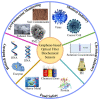Progress on Optical Fiber Biochemical Sensors Based on Graphene
- PMID: 35334640
- PMCID: PMC8951465
- DOI: 10.3390/mi13030348
Progress on Optical Fiber Biochemical Sensors Based on Graphene
Abstract
Graphene, a novel form of the hexagonal honeycomb two-dimensional carbon-based structural material with a zero-band gap and ultra-high specific surface area, has unique optoelectronic capabilities, promising a suitable basis for its application in the field of optical fiber sensing. Graphene optical fiber sensing has also been a hotspot in cross-research in biology, materials, medicine, and micro-nano devices in recent years, owing to prospective benefits, such as high sensitivity, small size, and strong anti-electromagnetic interference capability and so on. Here, the progress of optical fiber biochemical sensors based on graphene is reviewed. The fabrication of graphene materials and the sensing mechanism of the graphene-based optical fiber sensor are described. The typical research works of graphene-based optical fiber biochemical sensor, such as long-period fiber grating, Bragg fiber grating, no-core fiber and photonic crystal fiber are introduced, respectively. Finally, prospects for graphene-based optical fiber biochemical sensing technology will also be covered, which will provide an important reference for the development of graphene-based optical fiber biochemical sensors.
Keywords: biochemical sensor; evanescent wave; fiber grating; graphene; optical fiber; photonic crystal fiber.
Conflict of interest statement
All the authors declare no conflict of interest.
Figures









References
-
- Choi W., Lahiri I., Seelaboyina R., Kang Y.S. Synthesis of Graphene and Its Applications: A Review. Crit. Rev. Solid State Mater. Sci. 2010;35:52–71. doi: 10.1080/10408430903505036. - DOI
-
- Novodchuk I., Bajcsy M., Yavuz M. Graphene-based field effect transistor biosensors for breast cancer detection: A review on biosensing strategies. Carbon. 2021;172:431–453. doi: 10.1016/j.carbon.2020.10.048. - DOI
Publication types
Grants and funding
- Nos. 62165004, 61765004/National Science Foundation of China
- Nos. 2021KWZ-11, 2020KW-005/International Science & Technology Cooperation and Exchanges Project of Shaanxi
- Nos. SKLST201802, SKLST201809/Open Research Fund of State Key Laboratory of Transient Optics and Photonics
- No. 2020YZ0017/Key Sciences and Technology Project of Xi'an City
LinkOut - more resources
Full Text Sources
Miscellaneous

